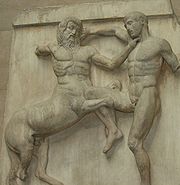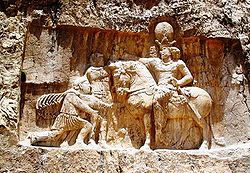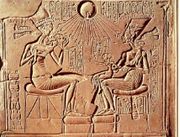Relief

A relief is a sculptured artwork where a carved or modelled form is raised—or, in a sunken-relief, lowered—from a plane from which the main elements of the composition project (or sink). Raising or lowering the plane is done by removing —in the case of a carved raised relief— material not relevant to the image, or —in the case of sunken relief— the material comprising the image (thus carving out the image). Reliefs are common throughout the world, for example on the walls of monumental buildings. The frieze in the classical Corinthian order is often enriched with bas-relief (low relief). Alto-relievo (high-relief) may be seen in the pediments of classical temples, e.g., the Parthenon. Several panels or sections of relief together may represent a sequence of scenes.
Contents |
Types

There are three main types of relief. The drawing of the distinction between high and low is often drawn differently, and in fact the two are very often combined in a single work - in particular most "high-reliefs" contain sections in "low-relief". Dashes may or may not be used in all these terms.
Bas-relief or low relief
A bas-relief ("low relief", French pronunciation: [baʁəljɛf], from the Italian basso rilievo) or low relief is the quality of a projecting image where the overall depth is shallow. The background is very compressed or completely flat, as on most coins, on which all images are in low-relief.

Bas-relief is very suitable for scenes with many figures and other elements such as a landscape or architectural background. A bas-relief may use any medium or technique of sculpture, but stone carving and metal casting are the traditional ones. If more than 50% of most rounded or cylindrical elements such as heads and legs project from the background, a sculpture is usually considered to be "alto rilievo" or "high relief", although the degree of relief within both types may vary across a composition, with prominent features such as faces in higher relief.
High relief
High relief (or alto relievo, from Italian) is where the most prominent elements of the composition are undercut and rendered at more than 50% in the round against the background.
All cultures and periods where large sculptures were created used this technique as one of their sculptural options. Seen in "monumental sculpture" and architecture from ancient times to present.
Sunken relief
Sunken-relief, also known as intaglio or hollow-relief, is where the image is made by carving into a flat surface - usually the images are mostly linear in nature. It is most notably associated with the Art of Ancient Egypt, where the strong sunlight usually needed to make the technique successful for images is present most of the time. In the sculpture of many cultures, including Europe, it is mostly used for inscriptions and engraved gems - the most likely meaning for "an intaglio".
Notable reliefs
Notable examples of reliefs include:
- Persepolis, 70 km northeast of the modern city of Shiraz in the Fars Province, Iran, treasury relief
- Naqsh-e Rustam, 12 km northwest of Persepolis in Fars province, Iran, rock-face relief
- Naqsh-e Rajab,12 km north of Persepolis in Fars province, Iran, rock-face relief
- Mount Rushmore National Memorial, Keystone, South Dakota, high relief
- Great Altar of Pergamon, now at the Pergamon Museum, Berlin, mostly high relief
- Lions and dragons from the Ishtar Gate, Babylon, low relief
- Temple of Karnak in Egypt, sunken relief
- Angkor Wat in Cambodia, mostly low relief
- The images of the elephant, horse, bull and lion at the bottom of the Lion Capital of Asoka, the national symbol of India (the capital itself is a full sculpture)
- Glyphs and artwork of the Maya civilization, low relief
- The monument to the Confederacy at Stone Mountain, Georgia
- Borobudur temple, Java Island Java, Indonesia
- The Elgin Marbles from the Parthenon, now housed at the British Museum, high and low relief.
- Frieze of Parnassus, high relief
- Robert Gould Shaw Memorial, Boston, mostly high relief.
- Stone Mountain, Georgia USA, the largest bas-relief in the world.
- Mamallapuram, Mahabalipuram, some of the finest and detailed enormous bas relief in the world.
See also
- Repoussé and chasing
Gallery
 Bas-relief in Persepolis - a symbol of Zoroastrian Nowruz - in day of a spring equinox power of eternally fighting bull (personifying the Earth), and a lion (personifying the Sun), are equal |
 Two Persian Soldiers in Persepolis |
 Rock-face relief at Naqsh-e Rustam of Iranian emperor Shapur I (on horseback) capturing Roman emperor Valerian (kneeing) and Philip the Arab (standing) |
 Egyptian figures in "alto relievo" |
 Atropos cutting the thread of life. Ancient Greek low relief. |
Yaxchilan Lintel 24, a Mayan carving depicting a blood sacrifice |
12th century Romanesque portal of Christ in Majesty at Moissac Abbey |
|
|
Angled view of a panel with the story of Abraham from the Florence Gates of Paradise (see above). |
 Side view of high relief: Madonna and Child, marble of c. 1500/1510 by an unknown north Italian sculptor |
 Robert Gould Shaw Memorial, 1897, Boston, combining free-standing elements with high and low relief. |
A relatively modern high relief (depicting shipbuilding) in Bishopsgate, London. Note that some elements jut out of the frame of the image. |
|
Art Deco tiled bas relief, old Press-Citizen Building, Iowa City, Iowa. |
External links
- Heilbrunn Timeline of Art History, "American Relief Sculpture", Metropolitan Museum of Art, New York.
- Melissa Hardiman, "Bas-Relief Pathfinder"

